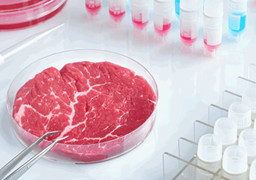[GT] л§ӣмһҲлҠ” 진м§ң мңЎлҘҳлҘј л°°м–‘н•ҳлҠ” мғҲлЎңмҡҙ кё°мҲ
л§Ҙл§ҲмҠӨн„° лҢҖн•ҷкөҗ(McMaster University)мқҳ м—°кө¬мһҗл“Өмқҙ лӢӨлҘё л°©лІ•ліҙлӢӨ лҚ” мһҗм—°мҠӨлҹ¬мҡҙ н’ҚлҜёмҷҖ м§Ҳк°җмқ„ м•ҪмҶҚн•ҳлҠ” л°©лІ•мқ„ мӮ¬мҡ©н•ҳм—¬ м „нҶөм Ғмқё лҸҷл¬ј кі кё°м—җ лҢҖн•ң мғҲлЎңмҡҙ лҢҖм•Ҳмқ„ к°ңл°ңн–ҲлӢӨ.
м—°кө¬мӣҗмһҗл“ӨмқҖ мӢӨн—ҳмӢӨ нҷҳкІҪм—җм„ң н•Ёк»ҳ мһҗлһҖ л°°м–‘лҗң к·јмңЎкіј м§Җл°© м„ёнҸ¬мқҳ м–ҮмқҖ мӢңнҠёлҘј мҢ“м•„ кі кё°лҘј л§Ңл“ңлҠ” л°©лІ•мқ„ кі м•Ҳн–ҲлӢӨ. мқҙ кё°мҲ мқҖ мқёк°„м—җкІҢ мқҙмӢқмқ„ мң„н•ҙ мЎ°м§Ғмқ„ м„ұмһҘмӢңнӮӨлҠ” лҚ° мӮ¬мҡ©лҗҳлҠ” л°©лІ•м—җм„ң м°Ёмҡ©лҗң кІғмқҙлӢӨ.
к°Ғк°Ғ н”„лҰ°н„° мҡ©м§Җ н•ң мһҘ л‘җк»ҳмқҳ мӮҙм•„мһҲлҠ” м„ёнҸ¬ мӢңнҠёлҠ” л°°м–‘м—җм„ң лЁјм Җ м„ұмһҘн•ң лӢӨмқҢ м„ұмһҘнҢҗм—җ лҶҚ축лҗң нӣ„ лІ—кІЁм§Җкі н•Ёк»ҳ мҢ“мқҙкұ°лӮҳ м ‘нһҢлӢӨ. мӢңнҠёлҠ” м„ёнҸ¬к°Җ мЈҪкё° м „м—җ мһҗм—°мҠӨлҹҪкІҢ м„ңлЎң кІ°н•©лҗңлӢӨ.
л Ҳмқҙм–ҙлҠ” л‘җк»ҳм—җ кҙҖкі„м—Ҷмқҙ лӢЁлӢЁн•ң мЎ°к°ҒмңјлЎң мҢ“мқ„ мҲҳ мһҲмңјл©° лӢӨлҘё лҢҖм•Ҳм—җ 비н•ҙ мЈјмҡ” мқҙм җмқё кі кё°мқҳ м§Җл°© н•Ёлҹүкіј л§Ҳлё”л§Ғмқ„ ліөм ңн•ҳлҸ„лЎқ вҖҳмЎ°м •вҖҷн• мҲҳлҸ„ мһҲлӢӨ.
мғҲлЎңмҡҙ л°©лІ•мқҖ кі кё° мЎ°к°Ғмқ„ л§Ңл“Өкі мҶҢ비мһҗлҠ” мҡ°мң мҷҖ л§Ҳм°¬к°Җм§ҖлЎң лӢӨм–‘н•ң 비мңЁмқҳ м§Җл°©мқҙ нҸ¬н•Ёлҗң кі кё°лҘј кө¬мһ…н• мҲҳ мһҲлӢӨ.
вҖҳм…Җ нӢ°мҠҲ мҳӨкұҙмҠӨ(Cell Tissue Organs)вҖҷ м Җл„җм—җ м„ӨлӘ…лҗң л°”мҷҖ к°ҷмқҙ, м—°кө¬мһҗл“ӨмқҖ мӮ¬мҡ© к°ҖлҠҘн•ң мҘҗ м„ёнҸ¬ кі„нҶөм—җм„ң кі кё°лҘј л§Ңл“Өм–ҙ мқҙ к°ңл…җмқ„ мҰқлӘ…н–ҲлӢӨ. к·ёл“ӨмқҖ м—°кө¬ л…јл¬ём—җм„ң м„ӨлӘ…н•ң мҘҗ кі кё°лҘј лЁ№м§ҖлҠ” м•Ҡм•ҳм§Җл§Ң лӮҳмӨ‘м—җ нҶ лҒј м„ёнҸ¬м—җм„ң л§Ңл“ кі кё° мғҳн”Ңмқ„ л§Ңл“Өкі мқҙлҘј мҡ”лҰ¬н–ҲлӢӨ. кІ°кіјлҠ” лҸҷл¬јмқҳ м „нҶөм Ғмқё кі кё°мҷҖ к°ҷмқҖ лҠҗлӮҢкіј л§ӣмқҙм—ҲлӢӨ.
лҸҷмқјн•ң кё°мҲ мқҙ мҮ кі кё°, лҸјм§Җкі кё° лҳҗлҠ” лӢӯкі кё°лҘј мһ¬л°°н•ҳлҠ” лҚ°лҸ„ нҡЁкіјк°Җ м—Ҷмқ„ кІғмңјлЎң кі л Өлҗҳл©°, мқҙ лӘЁлҚёмқҖ лҢҖк·ңлӘЁ мғқмӮ°м—җ м Ғн•©н• кІғмқҙлӢӨ.
м—°кө¬мһҗл“ӨмқҖ нҳ„мһ¬мқҳ мңЎлҘҳ мҶҢ비к°Җ мқҙлҜё нҶ м§ҖмҷҖ мҲҳмһҗмӣҗм—җ л¶ҖлӢҙмқ„ мЈјкі мһҲлҠ” лҚ°лҸ„ л¶Ҳкө¬н•ҳкі , мңЎлҘҳм—җ лҢҖн•ң м „ м„ёкі„ мҲҳмҡ”мқҳ мҰқк°Җн•ҳкі мһҲлӢӨлҠ” м җм—җм„ң мқҙ м—°кө¬лҘј кі„нҡҚн–ҲлӢӨ.
мһҘкё°м ҒмңјлЎң м „нҶөм Ғмқё мңЎлҘҳ мғқмӮ°мқҖ мқҙм ң м§ҖмҶҚ к°ҖлҠҘн•ҳм§Җ м•ҠлӢӨ. л”°лқјм„ң кі кё°лҘј л§Ңл“ңлҠ” лӢӨлҘё л°©лІ•мқҙ мһҲм–ҙм•ј н•ңлӢӨ.
лҸҷл¬јмқ„ нӮӨмҡ°кі мҲҳнҷ•н•ҳм§Җ м•Ҡкі лҸ„ мӢ м„ н•ң кі кё°лҘј мғқмӮ°н•ҳлҠ” кІғмқҖ лҚ” м§ҖмҶҚ к°ҖлҠҘн•ҳкі лҚ” мң„мғқм Ғмқҙл©° лҚң лӮӯ비к°Җ лҗ кІғмқҙлӢӨ. мқҙм „м—җ к°ңл°ңлҗң лӢӨлҘё л°°м–‘мңЎ мғқмӮ° лҢҖм•Ҳкіј лӢ¬лҰ¬ л§Ҙл§ҲмҠӨн„° лҢҖн•ҷмқҳ л°©лІ•мқҖ мҶҢ비мһҗк°Җ мҲҳмҡ©н•ҳкі мҰҗкёё мҲҳ мһҲкі к°җлӢ№н• мҲҳ мһҲлҠ” м ңн’Ҳмқ„ л§Ңл“Ө к°ҖлҠҘм„ұмқҙ лҚ” нҒ¬лӢӨ.
м—°кө¬мһҗл“ӨмқҖ мқҙлҜё кё°мҲ мғҒмҡ©нҷ”лҘј мӢңмһ‘н•ҳкё° мң„н•ҙ мӢ мғқ нҡҢмӮ¬лҘј м„ӨлҰҪн–ҲлӢӨ.
Reference:
CELLS TISSUES ORGANS, 2021, вҖңEngineering Murine Adipocytes and Skeletal Muscle Cells in Meat-like Constructs Using Self- Assembled Layer-by-Layer Biofabrication: A Platform for Development of Cultivated Meat,вҖқ by Alireza Shahin-Shamsabadi, P. Ravi Selvaganapathy. © 2021 Karger AG. Basel. All rights reserved.
To view or purchase this article, please visit:
Engineering Murine Adipocytes and Skeletal Muscle Cells in Meat-like Constructs Using Self-Assembled Layer-by- Layer Biofabrication: A Platform for Development of Cultivated Meat - Abstract - Cells Tissues Organs - Karger Publishers







